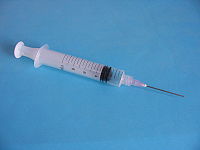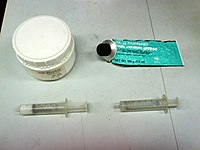Syringe

A syringe is simple piston pump consisting of a plunger that fits tightly in a tube. The plunger can be pulled and pushed along inside a cylindrical tube (the barrel), allowing the syringe to take in and expel a liquid or gas through an orifice at the open end of the tube. The open end of the syringe may be fitted with a hypodermic needle, a nozzle, or tubing to help direct the flow into and out of the barrel. Syringes are often used to administer injections, apply compounds such as glue or lubricant, and measure liquids.
The word "syringe" came from the Greek συριγξ = "tube" via extracting a new singular from its Greek-type plural "syringes" (συριγγες)
Medical syringes

Hypodermic syringes are used with hypodermic needles to inject liquid or gases into body tissues, or to remove from the body. Injecting of air into a blood vessel is undesirable, as it may cause an air embolism; preventing embolisms by removing air from the syringe is one of the reasons for the familiar image of holding a hypodermic syringe upside down, tapping it, and expelling a small amount of liquid before an injection into the bloodstream. However, the primary reason air bubbles are removed from the syringe prior to injection is to make sure an accurate dosage is delivered.
The barrel of a syringe is made of plastic or glass, and usually has graduated marks indicating the volume of fluid in the syringe, and is nearly always transparent. Glass syringes may be sterilized in an autoclave. However, most modern medical syringes are plastic with a rubber piston, because this type seals much better between the piston and the barrel and because they are cheap enough to dispose of after being used only once, reducing the risk of spreading blood-borne diseases. Re-use of needles and syringes has caused spread of diseases, especially HIV and Hepatitis among intravenous drug users. Syringes are commonly re-used by diabetics and this is safe, if the syringe is only used by one person.
Medical syringes are sometimes used without a needle for orally administering liquid medicines to young children or animals, or milk to small young animals, because the dose can be measured accurately, and it is easier to squirt the medicine into the subject's mouth instead of coaxing the subject to drink out of a measuring spoon.
Standard U-100 insulin syringes

Syringes for insulin users are designed for standard U-100 insulin. The dilution of insulin is such that 1 ml of insulin fluid has 100 standard "units" of insulin. Since insulin vials are typically 10 ml, each vial has 1000 units.
Insulin syringes are made specifically for self injections and have friendly features:
- shorter needles, as insulin injections are subcutaneous (under the skin) rather than intramuscular,
- finer gauge needles, for less pain, and
- markings in insulin units to simplify drawing a measured dose of insulin.
Multishot needle syringes
There are needle syringes designed to reload from a built-in tank (container) after each injection, so they can make several or many injections on a filling. These are not used much in human medicine because of the risk of cross-infection via the needle. An exception is the personal insulin autoinjector used by diabetic patients.
Governmental control of syringes
In some jurisdictions, the sale or possession of hypodermic syringes may be controlled or prohibited without a prescription, due to its potential use with illegal intravenous drugs.
Non-medical uses
The syringe has many non medical applications.
Laboratory applications

Medical-grade disposable hypodermic syringes are often used in research laboratories for convenience and low cost. They are often used for measuring and transferring solvents and reagents where a high precision is not required. Alternatively, microliter syringes can be used to measure and dose chemicals very precisely by using a small diameter capillary as the syringe barrel.
The polyethylene construction of these disposable syringes usually makes them rather chemically resistant. There is, however, a risk of the contents of the syringes leaching plasticizers from the syringe material. Non-disposable glass syringes may be preferred where this is a problem. Glass syringes may also be preferred where a very high degree of precision is important (i.e. quantitative chemical analysis), because their engineering tolerances are lower and the plungers move more smoothly. In these applications, the transfer of pathogens is usually not an issue.
Used with a long needle or cannula, syringes are also useful for transferring fluids through rubber septa when atmospheric oxygen or moisture are being excluded. Examples include the transfer of air-sensitive or pyrophoric reagents such as phenylmagnesium bromide and n-butyllithium respectively. Glass syringes are also used to inject small samples for gas chromatography (1 μl) and mass spectrometry (10 μl). Syringe drivers may be used with the syringe as well.

Cooking
Some culinary uses of syringes are injecting liquids (such as gravy) into other foods, or for the manufacture of candies, such as Fruit Gushers.
Syringes may also be used when cooking meat to enhance flavor and texture by injecting juices inside the meat, and in baking to inject filling inside a pastry.
Others
Syringes are used to refill ink cartridges with ink.
Sometimes a large hypodermic syringe is used without a needle for very small baby mammals to suckle from in artificial rearing.
Historically, large pumps that use reciprocating motion to pump water were refered to as syringes. Pumps of this type were used as early firefighting equipment.
To administer enemas or douches, there are bulb syringes where a bulb is fitted with a nozzle, liquid is pumped into it, the nozzle is inserted into the rectum or vagina and the bulb is pressed upon for injection.
There are fountain syringes where the liquid is in a bag or can and goes to the nozzle via a pipe. In earlier times, clyster syringes were used for that purpose.
Loose snus is often applied using modified Syringes. The nozzle is removed so the opening is the width of the chamber. The snus can be packed tightly into the chamber and plunged into the upper lip. Syringes, called portioners, are also manufactured for this particular purpose.
Historical timeline
- 9th century: The Iraqi/Egyptian surgeon Ammar ibn 'Ali al-Mawsili' technically invented the first such syringe in the 9th century using a hollow glass tube and suction to remove cataracts from patients' eyes, a practice that remained in use up until at least the 13th century and which came into renewed use in the 20th century.
- c. 1650: Blaise Pascal invented a syringe (not necessarily hypodermic) as an application of what is now called Pascal's law.
- 1760: Forms of intravenous injection and infusion began.
- 1844: Irish physician Francis Rynd invented the hollow needle and used it to make the first recorded subcutaneous injections, specifically a sedative to treat neuralgia.
- 1853: Charles Gabriel Pravaz and Alexander Wood first developed a medical hypodermic syringe with a needle fine enough to pierce the skin. Shortly thereafter, the first recorded fatality from a hypodermic-syringe induced overdose was Wood's wife from self administered morphine.
- 1956: New Zealand pharmacist and inventor Colin Murdoch granted New Zealand and Australian patents for a disposable plastic syringe.
- 1974: First US patent for a plastic disposable syringe received by African American inventor, Phil Brooks, U.S. patent #3,802,434 received on April 9, 1974.
See also
- Jet injector- injects without a needle, by squirting the injection fluid so fast that it makes a hole in the skin.
- Hypodermic needle
- Syrette - similar to a syringe except that it has a closed flexible tube (like that used for toothpaste) instead of a rigid tube and piston.
